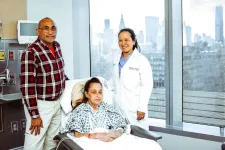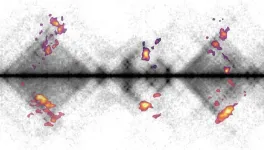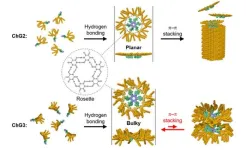(Press-News.org) (WASHINGTON, Nov. 21, 2024) — Participants of the American Society of Hematology (ASH) Minority Recruitment Initiative had lower attrition rates in graduate and medical programs, were more likely to pursue a career in hematology, and had high levels of engagement at ASH beyond their participation in the program, according to a study published today in Blood Advances.
The ASH Minority Recruitment Initiative was established in 2003 following a report from the Institute of Medicine that called for greater workforce diversity. The program aimed to recruit physicians and physician/scientists from communities underrepresented in hematology into the field through paid research opportunities and mentorship. Over the course of 20 years, the program grew to support prospective hematologists from medical school through fellowship and into early career, creating a longitudinal pathway of support. A longitudinal pathway also exists for doctoral scientists that begins during graduate school and ends with a post-doctoral award.
“Patients feel more confident in their physician if it’s someone they can relate to,” said study author Belinda R. Avalos, MD, ASH president-elect. “Previous literature has shown that patients and physicians from the same race or ethnicity have better relationships and stronger health outcomes.”
Black individuals, who constitute 13.6% of the U.S. population, and individuals of Hispanic descent, who constitute 18.9% of the U.S. population, make up only 4.1% and 5.7% of hematology-oncology trainees, respectively.
In a 20-year retrospective analysis of the program, Dr. Avalos and her colleagues evaluated its short- and long-term impact. From 2004 to 2022, there were 405 participants across the six awards programs on the longitudinal career pathway.
From 2004 to 2018, medical school attrition of 181 program participants was 2.2% compared to the national minority medical school attrition of 5.6%, while graduate school attrition of 32 participants from 2011 to 2017 was 0%, significantly lower than the 36% attrition rate for minority doctoral students in science and engineering fields. Additionally, of the 77 participants who received two or more program awards, 25 received awards that directly progressed on the pathway.
“We were very intentional about including mentorship and peer connections early on in the program pathway so that participants were supported along their journey,” said study author Deirdra R. Terrell, PhD, associate professor of epidemiology and assistant dean for sovereignty, opportunity, belonging, and engagement at the University of Oklahoma Health Sciences. “These lower attrition rates show that participants created their own networks – a group of people to connect with, text for advice, and gain empowerment from after hearing their stories.”
Program participants were more likely to pursue hematology-oncology and remain in the field. Of the 97 participants who received a medical school award from 2004 to 2014, 14.4% were board-eligible or board-certified in hematology-oncology. Additionally, most recipients of the early career award (25 out of 26) remained in academia, with 88.5% practicing in hematology. These percentages are significantly greater than the 5.7% underrepresented minority faculty in medical oncology (which included hematology-oncology) reported in national estimates in 2019.
The majority of program participants received the medical student award (240 awards from 2004 to 2022), self-identified as Black or Hispanic, and attended or were faculty (early career award) at a U.S. academic institution. For all awards, except the early career award, most recipients self-identified as female.
The ASH Minority Recruitment Initiative participants were highly involved at ASH even after completing the program. Forty-five alumni served in 353 leadership roles at ASH and from 2004 to 2022, 59% (225 out of 353) of participants were authors on 1,105 abstracts presented at an ASH annual meeting.
“Participants who stayed in hematology are now the voices driving changes in other parts of ASH,” said Dr. Avalos. “We now have more diverse voices in the ASH ecosystem, whether in the executive committee, guidelines process, or editorial teams.”
Due to its retrospective nature, the study did have some limitations, including obtaining medical specialty outcomes through publicly available data, resulting in a conservative estimate of retention in hematology, and identifying an appropriate comparison group.
The researchers plan to further evaluate and bolster the program’s impact by implementing a standard annual assessment tool for all awardees, including a formal mixed methods assessment to better understand the awards’ impact on careers, and conducting more outreach through the ASH Ambassador Program in areas of the country that have not yet had an awardee.
“This program has built a community of people who want to do good science and good things in the world,” said Dr. Terrell. She urged other institutions to consider this success as evidence that similar programs are worth the investment and commitment. “Programs like this work, make a difference, and are necessary. We need to continue making sure everyone is represented at the table.”
ASH is continuing to foster and empower a diverse new generation of leaders in hematology through the Hematology Inclusion Pathway (HIP), the successor program to the Minority Recruitment Initiative. To learn more about ASH’s HIP, visit hematology.org/awards/hematology-inclusion-pathway.
###
Blood Advances (bloodadvances.org) is an online, open-access journal publishing more peer-reviewed hematology research than any other academic journal worldwide. Blood Advances is part of the Blood journals portfolio (bloodjournals.org) from the American Society of Hematology (ASH) (hematology.org).
Claire Whetzel, 202-629-5085
cwhetzel@hematology.org
END
ASH inclusion program retained and engaged hematologists underrepresented in field, 20-year analysis shows
Participants were more likely to complete graduate and medical programs, pursue a career in hematology
2024-11-21
ELSE PRESS RELEASES FROM THIS DATE:
How anti-obesity drugs are linked to food waste
2024-11-21
COLUMBUS, Ohio – Taking anti-obesity drugs has led some U.S. adults to throw away more food than they tossed before starting the medications, a new study has found.
In a survey of people currently on GLP-1 medications such as Ozempic, 25% of respondents agreed they had wasted more food since taking the drugs, compared to 61% who disagreed. People who were nauseated by the drugs were more likely to report increased food waste. Being on the medications for a longer period of time and eating more vegetables were associated with less food waste.
Scientists at The Ohio State University see this study of consumer behavior as an initial effort to consider the effects ...
Discovery explains kidney damage caused by blood pressure drugs
2024-11-21
University of Virginia School of Medicine researchers have discovered how long-term treatment of high blood pressure with commonly prescribed drugs can destroy the kidney’s ability to filter and purify blood. The finding could open the door to better ways to manage high blood pressure and other vascular diseases.
The class of drugs, known as renin–angiotensin system (RAS) inhibitors, block the effects of the renin enzyme, relaxing blood vessels and allowing blood to flow more easily. They are widely used as first-line medications for hypertension (high blood pressure). But long-term use can take a terrible toll on the ...
NYU Langone performs world’s first fully robotic double lung transplant
2024-11-21
NEW YORK, NY, NOV. 21, 2024—A surgical team at NYU Langone Health has performed the first fully robotic double lung transplant in the world. The procedure marks a breakthrough in the potential of robotic surgery and minimally invasive patient care, making NYU Langone the new leader in robotic transplant surgery around the globe.
Stephanie H. Chang, MD, associate professor in the Department of Cardiothoracic Surgery at NYU Grossman School of Medicine and surgical director of the Lung Transplant Program ...
APSS accepting sleep and circadian research abstracts and session proposals for SLEEP 2025 in Seattle
2024-11-21
DARIEN, IL – The Associated Professional Sleep Societies is accepting research abstracts and session proposal submissions for SLEEP 2025, the 39th annual meeting of the APSS, which will be held June 8 to 11 at the Seattle Convention Center.
Research abstracts will be accepted for oral and poster presentations. Hot topics for 2025 include machine learning and artificial intelligence, metabolomics and genomics, sleep and the glymphatic system, orexin pharmacology, and obesity management. Accepted abstracts ...
DNA repair: A look inside the cell’s ‘repair café’
2024-11-21
New research from the Kind Group at the Hubrecht Institute sheds light on how cells repair damaged DNA. For the first time, the team has mapped the activity of repair proteins in individual human cells. The study demonstrates how these proteins collaborate in so-called "hubs" to repair DNA damage. This knowledge offers opportunities to improve cancer therapies and other treatments where DNA repair is essential. The researchers published their findings in Nature Communications on November 21.
DNA is the molecule that carries our genetic information. It can be damaged by normal cellular processes as well as external factors such as UV radiation ...
Astronomers take the first close-up picture of a star outside our galaxy
2024-11-21
“For the first time, we have succeeded in taking a zoomed-in image of a dying star in a galaxy outside our own Milky Way,” says Keiichi Ohnaka, an astrophysicist from Universidad Andrés Bello in Chile. Located a staggering 160 000 light-years from us, the star WOH G64 was imaged thanks to the impressive sharpness offered by the European Southern Observatory’s Very Large Telescope Interferometer (ESO’s VLTI). The new observations reveal a star puffing out gas and dust, in the last stages before it becomes a supernova.
“We discovered an ...
Here’s something Americans agree on: Sports build character
2024-11-21
COLUMBUS, Ohio – In a polarized nation, there is one thing that nearly all Americans agree on, according to a recent study: Sports are good for us.
Researchers from The Ohio State University and Ithaca College found that more than 9 out of 10 Americans agreed that sports build character and improved one’s health, while 84% agreed playing sports makes one popular in school and 85% said it makes one more well-known in the community.
According to 67% of those surveyed, playing sports even leads to better grades in school.
While these beliefs may seem harmless, ...
Engineering nature’s blueprint: Dendron-based assemblies for chlorophyll’s materials
2024-11-21
Researchers often look to photosynthesis—a process that turns sunlight into chemical energy in plants and bacteria—as a model for innovation. Photosynthesis is in turn linked to chlorophyll pigments, tiny green molecules that play a key role in harvesting light. Naturally, these chlorophyll molecules are organized into precise structures to optimize light absorption in plants and bacteria, and efficiently capture sunlight for energy. Inspired by this natural structure, scientists have explored ways to synthetically assemble chlorophyll-based ...
Study reveals how cell types shape human brain networks
2024-11-21
Rutgers researchers at the Brain Health Institute (BHI) and Center for Advanced Human Brain Imaging Research (CAHBIR) have uncovered how different types of brain cells work together to form large-scale functional networks in the human brain – interconnected systems that support everything from sensory processing to complex decision-making – paving the way for new insights into brain health and disease.
By pinpointing these cellular foundations, the study, published in Nature Neuroscience, offers a deeper understanding of the cellular foundations of cognition and mental health.
The brain’s functional properties arise from the varied ...
New genetic explanation for heart condition revealed
2024-11-21
A potentially life-changing heart condition, dilated cardiomyopathy, can be caused by the cumulative influence of hundreds or thousands of genes and not just by a single “aberrant” genetic variant, as was previously thought, finds a new study led by researchers at UCL (University College London), Imperial College London and the MRC Laboratory of Medical Sciences.
Dilated cardiomyopathy (DCM) is a condition in which the heart becomes progressively enlarged and weakened, reducing its ability to pump blood efficiently. It is estimated to affect up to 260,000 people in the UK (one in every 250 individuals) and is the leading cause of heart transplantation.
Previously, ...
LAST 30 PRESS RELEASES:
Making lighter work of calculating fluid and heat flow
Normalizing blood sugar can halve heart attack risk
Lowering blood sugar cuts heart attack risk in people with prediabetes
Study links genetic variants to risk of blinding eye disease in premature infants
Non-opioid ‘pain sponge’ therapy halts cartilage degeneration and relieves chronic pain
AI can pick up cultural values by mimicking how kids learn
China’s ecological redlines offer fast track to 30 x 30 global conservation goal
Invisible indoor threats: emerging household contaminants and their growing risks to human health
Adding antibody treatment to chemo boosts outcomes for children with rare cancer
Germline pathogenic variants among women without a history of breast cancer
Tanning beds triple melanoma risk, potentially causing broad DNA damage
Unique bond identified as key to viral infection speed
Indoor tanning makes youthful skin much older on a genetic level
Mouse model sheds new light on the causes and potential solutions to human GI problems linked to muscular dystrophy
The Journal of Nuclear Medicine ahead-of-print tip sheet: December 12, 2025
Smarter tools for peering into the microscopic world
Applications open for funding to conduct research in the Kinsey Institute archives
Global measure underestimates the severity of food insecurity
Child survivors of critical illness are missing out on timely follow up care
Risk-based vs annual breast cancer screening / the WISDOM randomized clinical trial
University of Toronto launches Electric Vehicle Innovation Ontario to accelerate advanced EV technologies and build Canada’s innovation advantage
Early relapse predicts poor outcomes in aggressive blood cancer
American College of Lifestyle Medicine applauds two CMS models aligned with lifestyle medicine practice and reimbursement
Clinical trial finds cannabis use not a barrier to quitting nicotine vaping
Supplemental nutrition assistance program policies and food insecurity
Switching immune cells to “night mode” could limit damage after a heart attack, study suggests
URI-based Global RIghts Project report spotlights continued troubling trends in worldwide inhumane treatment
Neutrophils are less aggressive at night, explaining why nighttime heart attacks cause less damage than daytime events
Menopausal hormone therapy may not pose breast cancer risk for women with BRCA mutations
Mobile health tool may improve quality of life for adolescent and young adult breast cancer survivors
[Press-News.org] ASH inclusion program retained and engaged hematologists underrepresented in field, 20-year analysis showsParticipants were more likely to complete graduate and medical programs, pursue a career in hematology



